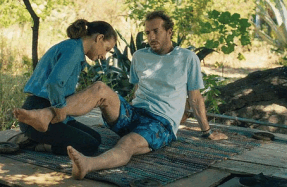

One of the best known of Steve McQueen’s early video works is Deadpan (1997), a four-minute, 35-second loop in which the artist simultaneously places himself in harm’s way and in film history. The piece is a recreation of the famous Buster Keaton stunt from Steamboat Bill, Jr. (1928) in which the façade of a two-story wooden house falls in on Buster. The performer isn’t crushed by the falling structure because he is standing in the exact position for the window to fall around him, engulfing Keaton in destruction but sparing him as he displays his trademark unflappability.
In McQueen’s version, the event is shown from multiple perspectives—profile, ¾ angle, bird’s-eye—as well as being fragmented into close-ups of the artist’s feet, face, and torso. The dangerous stunt is repeated as a loop, and even though we know that we’re watching multiple shots of a single action, this repetition heightens anxiety rather than tamping it down. But what is more significant about Deadpan is the placement of McQueen’s body at the centre of the image, at the heart of this “comic” event.
Keaton is replaced by McQueen’s contemporary presence: white T-shirt, trainers, and jeans, staring impassively at the camera, just waiting for the inevitable slam of the façade around him. Where Keaton’s stoicism was the crux of his humour, McQueen’s is cast quite differently. As a Black body, McQueen’s safety is predicated on standing stock-still, as if police had shouted at him to “freeze” or “don’t move.” This man’s survival depends on keeping his cool, remaining in absolute control of himself, in the midst of structural collapse. A system has been devised to destroy him; one false move and he is killed or maimed. His only chance is to occupy the structure and behave as though he belongs there, in the hope that he finds the window and the window finds him.
But McQueen’s window has widened. The filmmaker’s career is no longer restricted to the museum world, and his newest project, anthology, once again goes right to the centre of dominant histories, bringing Blackness to bear in places where it had previously been conspicuous in its absence. , commissioned by the BBC, in many respects adopts the format and thematic approach of the network’s award-winning telefilm series . This series, which ran from 1970 to 1984, consisted of highend made-for-TV films, mostly adhering to a general kitchen-sink realist approach. While some episodes functioned as light entertainment, a great many focused on left-leaning political and cultural matters, such as the travails of the working poor, labour struggles, failures of the welfare state, and, eventually, the crushing rise of Thatcherism.






